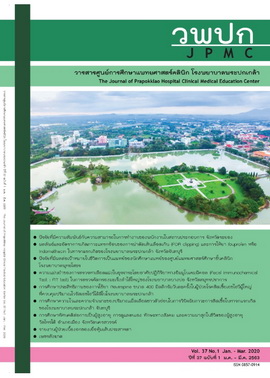Outcome and Complication Rates of PDA Clipping and Ibuprofen/Indomethacin in The Neonates at Prapokklao Hospital
Main Article Content
Abstract
Background: The primary closure of the ductus arteriosus is typically completed on the first day after birth, although it may be delayed for several days. Ontogenic differences in physiological factors almost certainly account for the higher incidence of persistent patency of the ductus arteriosus (PDA) in preterm infants. The incidence of PDA in preterm newborns is 18-77%. Aggressive, urgent treatment of a significant PDA is required if there are signs of congestive heart failure. The use of oral Ibuprofen or intravenous Indomethacin to constrict the PDA has led to successful nonsurgical closure in about 60-80% of interventions. If medical treatment is unsuccessful or not possible, surgical closure can be performed with 1-5% mortality.
Objectives: To study and perform data collection about the efficacy and adverse reactions of Ibuprofen/Indomethacin and surgical PDA closure at Prapokklao Hospital.
Materials and methods: Cross-sectional study. We included all newborns with PDA from June 1, 2017 to March 31, 2018. The collected data included demographic data, echocardiography, comorbidity, and management strategies. A prospective analysis was conducted about outcomes and adverse reactions of each treatment strategy including medication and surgical PDA closure.
Results: The incidence of PDA in preterm infants is 9.4% and higher than full-term newborns (1.6%). Successful treatment with Ibuprofen/Indomethacin was demonstrated to be as high as 78.5%. Overall incidences of transient side effects were 11.4%. This study confirms both to be excellent and successful treatments with 0% mortality.
Conclusion: Successful treatment with Ibuprofen/Indomethacin was demonstrated to be as high as 84.6% with low side effects. Surgery now can be performed with minimal morbidity and mortality.
Article Details
References
Coggin CJ, Parker KR, Keith JD. Natural history of isolated patent ductus arteriosus and the effect of surgical correction: twenty years’ experience at The Hospital for Sick Children, Toronto. Can Med Assoc J 1970;102:718-20.
Gardiner JH, Keith JD. Prevalence of heart disease in Toronto children. Pediatrics 1951;7:713-21.
Thebaud B, Wu XC, Kajimoto H, Bonnet S, Hashimoto K, Michelakis ED, et al. Development absence of the O2 sensitivity of L-type calcium channels in preterm ductus arteriosus smooth muscle cells impairs O2 constriction contributing to patent ductus arteriosus. Pediatr Res 2008;63:176-81.
Clyman RI, Mauray F, Roman C, Rudolph AM, Heymann MA. Circulating prostaglandin E2 concentrations and patent ductus arteriosus in fetal and neonatal lambs. J Pediatr 1980;97:455-61.
Waleh N, Kajino H, Marrache AM, Ginzinger D, Roman C, Seidner SR, et al. Prostaglandin E2-mediated relaxation of the ductus arteriosus: effects of gestational age on g protein-coupled receptor expression, signaling, and vasomotor control. Circulation 2004;110:2326-32
Momma K, Toyono M. The role of nitric oxide in dilating the fetal ductus arteriosus in rats. Pediatr Res 1999;46:311-5.
Mouzinho Al, Rosenfeld CR, Risser R. Symptomatic patent ductus arteriosus in very-low-birth-weight infants:1987-1989. Early Hum Dev 1991;27:65-77.
Friedman WF, Hirschklau MJ, Printz MP, Pitlick PT, Kirkpatrick SE. Pharmacologic closure of patent ductus arteriosus in the premature infant. N Engl J Med 1976;295:526-9.
Heymann MA, Rudolph AM, Silverman NH. Closure of the ductus arteriosus in premature infants by inhibition of prostaglandin system. N Engl J Med 1976;295:530-3.
Sivanandan S, Bali V, Soraisham AS, Harabor A, Kamaluddeen M, Effectiveness and safety of indomethacin versus ibuprofen for the treatment of patent ductus arteriosus in preterm infants. Am J Perinatol 2013;30:745-50.
Ohlsson A, Walia R, Shah SS. Ibuprofen for the treatment of patent ductus arteriosus in preterm and/or low birth weight infants. Cochrane Database Syst Rev[Internet]2013 [cited 2018 Nov 21]. Available from: https://www-cochranelibrary-com.cuml1.md.chula.ac.th/cdsr/doi/10.1002/14651858.CD003481.pub5/epdf/standard
Neumann R, Schulzke SM, Buhrer C. Oral ibuprofen versus intravenous ibuprofen or intravenous indomethacin for the treatment of patent ductus arteriosus in preterm infants: a systematic review and meta-analysis. Neonatology 2012;102:9-15.
Chotigeat U, Jirapapa K, Layangkool T. A comparison of oral ibuprofen and intravenous indomethacin for closure of patent ductus arteriosus in preterm infants. J Med Assoc Thai 2003;86(Suppl3):563-9.
Supapannachart S, Limrungsikul A, Khowsathit P. Oral ibuprofen and indomethacin for treatment of patent ductus arteriosus in premature infants: a randomized trial at Ramathibodi Hospital. J Med Assoc Thai 2002;85(Suppl4):S1252-8.
Mavroudis C, Backer CL, Gevitz M. Forty-six years of patient ductus arteriosus division at Children’s Memorial Hospital of Chicago. standards for comparison. Ann Surg 1994;220:402-9
Hutchings K, Vasquez A, Price D, Cameron BH, Awan S, Miller GG. Outcomes following neonatal patent ductus arteriosus ligation done by pediatric surgeons: a retrospective cohort analysis. J Pediatr Surg 2013;48:915-8.
Jirasakuldeeh V, Anuroj K, Layangkool P. Incidence of patent ductus arteriosus (PDA) in preterm infants of gestational age less than 33 weeks at NICU Bhumibol Adulyadej Hospital between 2005-2007. Royal Thai Air Force medical gazette 2009;55:17-27.
Benjacholmas V, Namchaisiri J, Lertsarpcharoen P, Punnahitananda S, Thaithumyanon P. Short-term outcome of PDA ligation in the preterm infants at King Chulalongkorn Memorial Hospital, Thailand. J Med Assoc Thai 2009 ;92:909-13

